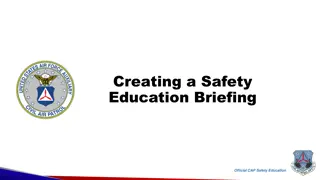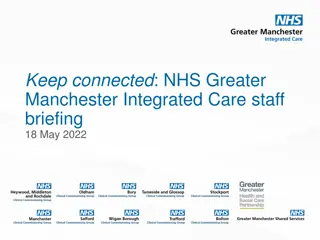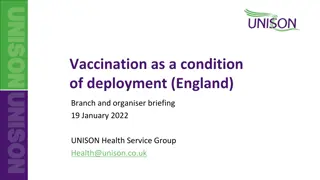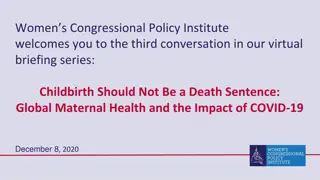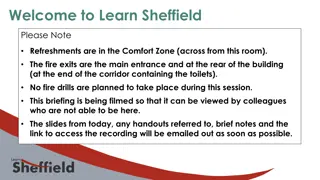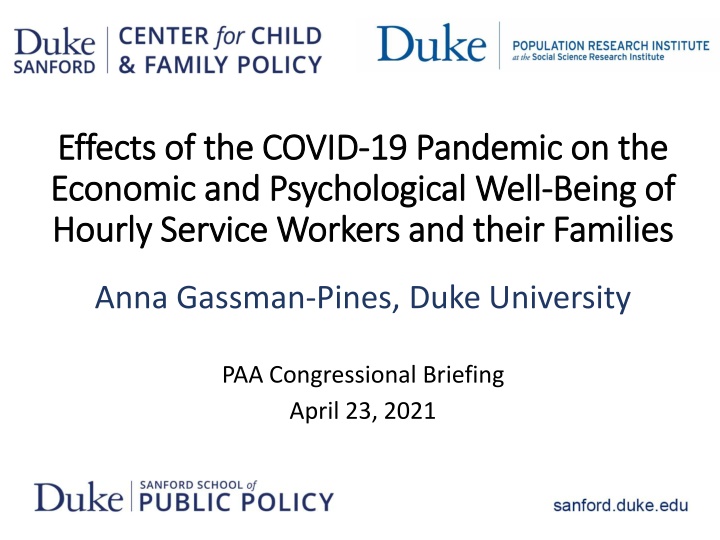
Impact of COVID-19 on Hourly Service Workers and Families: Economic and Psychological Effects
Explore the effects of the COVID-19 pandemic on the economic and psychological well-being of hourly service workers and their families, based on a study conducted by Anna Gassman-Pines from Duke University. The study reveals immediate declines in work and family well-being, high levels of job and income loss, caregiving burden, and alarming psychological distress among workers. Insights are gathered through ongoing daily surveys, highlighting the challenges faced by this vulnerable group during the pandemic.
Download Presentation

Please find below an Image/Link to download the presentation.
The content on the website is provided AS IS for your information and personal use only. It may not be sold, licensed, or shared on other websites without obtaining consent from the author. If you encounter any issues during the download, it is possible that the publisher has removed the file from their server.
You are allowed to download the files provided on this website for personal or commercial use, subject to the condition that they are used lawfully. All files are the property of their respective owners.
The content on the website is provided AS IS for your information and personal use only. It may not be sold, licensed, or shared on other websites without obtaining consent from the author.
E N D
Presentation Transcript
Effects of the COVID Effects of the COVID- -19 Pandemic on the Economic and Psychological Well Economic and Psychological Well- -Being of Hourly Service Workers and their Families Hourly Service Workers and their Families 19 Pandemic on the Being of Anna Gassman-Pines, Duke University PAA Congressional Briefing April 23, 2021
Ongoing daily survey Sample Characteristics St. Dev. Mean Sample of ~1,000 hourly service workers with young children in Philadelphia, recruited in late summer-fall, 2019 Race/ethnicity (%): African-American (non-Hispanic) White (non-Hispanic) Asian (non-Hispanic) Multi-racial (non-Hispanic) Hispanic (of any race) Age Female (%) Education (%): Less than a high school education Exactly a high school education Monthly household income 49.5% 18.2% 3.3% 2.3% 22.5% 31.0 83.1% 7.0 Originally focused on work schedule unpredictability and worker and family well-being 26.3% 44.3% $2,239 $1,672 Child characteristics Age Female (%) 4.9 50.0% 2.6
Ongoing daily survey Ask them about their work and home experiences and well-being via basic SMS text message every day for 2 weeks By mid-March, had ~700 re- enrolled
Immediate declines in work and family well Immediate declines in work and family well- -being once COVID once COVID- -19 restrictions put in place 19 restrictions put in place being
When pandemic began, we pivoted to ask about it Collected data throughout 2020 1stsurvey: Mid-March to late April (now published in Pediatrics*) High levels of job and income loss, caregiving burden, material hardship Alarming levels of psychological distress 2ndsurvey: May-June 3rdsurvey: September-November *Gassman-Pines, A., Ananat, E. O., & Fitz-Henley II, J. (2020). COVID-19 and parent-child psychological well-being. Pediatrics, 146(4).
Among those employed in April, income from work has been relatively stable since June 100% 90% 80% 70% 60% 50% 40% 30% 20% 10% 0% April June September November Lost more than 1/2 income Lost less than 1/2 income Stable income Higher income
Among those unemployed in April, income losses from work have been larger and have grown over time 100% 90% 80% 70% 60% 50% 40% 30% 20% 10% 0% April June September November Lost more than 1/2 income Lost less than 1/2 income Stable income Higher income
In May and June, government supports were helping buffer all families from large income losses 100% 90% 80% 70% 60% 50% 40% 30% 20% 10% 0% $ from work $ from work + gov't support $ from work $ from work + gov't support Employed in April Unemployed in April Lost more than 1/2 income Lost less than 1/2 income Stable income Higher income
But, these supports were temporary and had faded by September 100% 90% 80% 70% 60% 50% 40% 30% 20% 10% 0% $ from work $ from work + gov't support $ from work $ from work + gov't support Employed in April Unemployed in April Lost more than 1/2 income Lost less than 1/2 income Stable income Higher income
Pandemic benefits did not reach everyone: Pandemic benefits did not reach everyone: UI is an illustrative example UI is an illustrative example Of the workers who were laid off, 87% tried to apply for UI others said they thought they weren t eligible (8%), or that it seemed too difficult (5%) Of those who tried to apply, 95% got through the process Of those who successfully applied, 62% received UI Of those who received UI, 84% had PUC included in their check
Pandemic benefits did not reach everyone Pandemic benefits did not reach everyone Of the workers who were laid off, 87% tried to apply for UI others said they thought they weren t eligible (8%), or that it seemed too difficult (5%) Lower among Hispanic respondents, who perceive they are ineligible Of those who tried to apply, 95% got through the process Of those who successfully applied, 62% received UI Of those who received UI, 84% had PUC included in their check
Pandemic benefits did not reach everyone Pandemic benefits did not reach everyone Of the workers who were laid off, 87% tried to apply for UI others said they thought they weren t eligible (8%), or that it seemed too difficult (5%) Of those who tried to apply, 95% got through the process Lower among Black respondents, whose benefits were less likely to arrive Of those who successfully applied, 62% received UI Of those who received UI, 84% had PUC included in their check
Chronic mental health struggles In Fall 2020, nearly half of the parents screened positive for depression, anxiety or both 17% of parents report that children are sad or worried the majority of the time Chaotic schooling/care situations in first half of school year may be a significant driver
School/child care disruptions were common throughout the first half of the school year 26.1% 24.4% 23.9% 17.6% Overall In-person only Remote only Remote & in-person
Family well-being is worse on days with disruption to school or child care 12.7% 41.6% 9.2% 5.6% 6.0% 14.1% 7.0% 6.7% Child uncooperative (externalizing behavior) Child sad/worried (internalizing behavior) Parent lost temper with child Parent anxious/depressed Overall Increase when school is disrupted
Implications Continued supports for working families and the schools and child care facilities they use are needed Work/income December extension of expanded pandemic unemployment compensation an important first step Additional stimulus rolling out now will help even more More attention to ensuring that all families especially families of color receive benefits Mental health and other supports Strengthen systems addressing family mental health and invest in additional family supports Look for additional ways to aid schools and child care centers
Conclusions The effects of the COVID crisis on hourly service workers with young children on work, income, and well-being were immediate and striking Effects on families have persisted as pandemic persisted Policies aimed at providing income to families during the crisis helped but their reach has not been universal Little attention has been paid to family mental health needs Additional public supports will help families in need
Funding for this work provided by: Eunice Kennedy Shriver National Institute of Child Health and Human Development, National Institutes of Health (#1R21HD100893-01) National Science Foundation (# SES-1921190) Russell Sage Foundation (#1811-10382) Washington Center for Equitable Growth Thank you! agassman.pines@duke.edu




